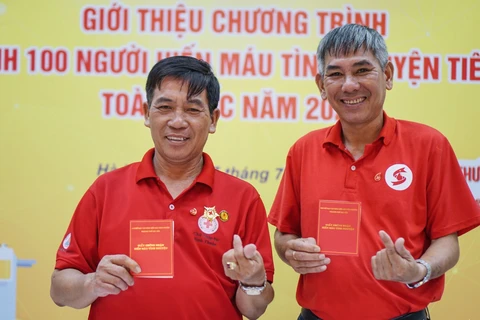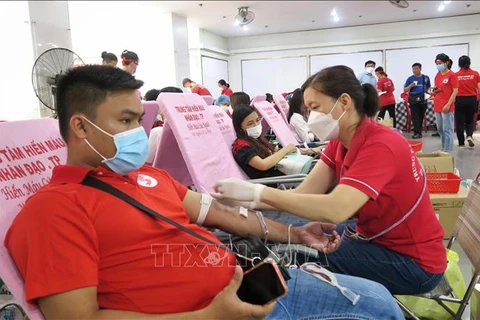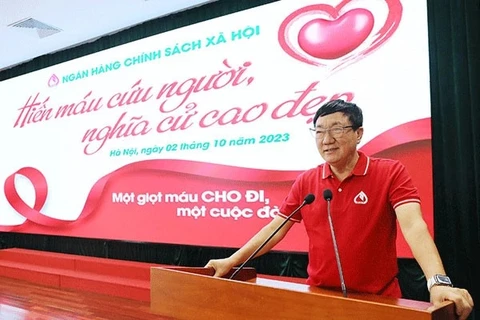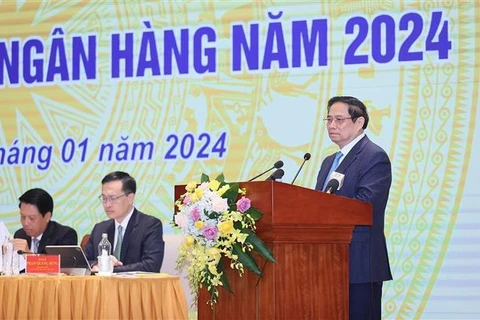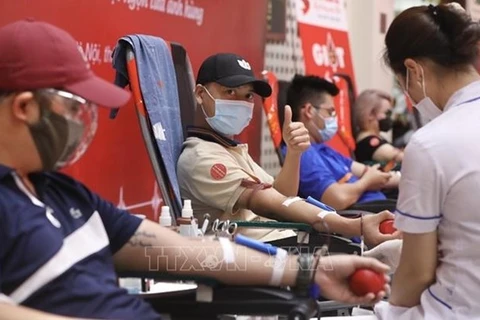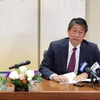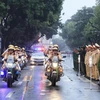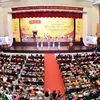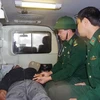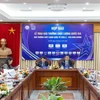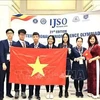Hanoi (VNA) – Over the last three decades, Vietnam has witnessed the strong development of the voluntary blood donation movement, which reflects not only people’s solidarity and humanity but also awareness improvement in society.
It is a journey of sharing love, compassion, and solidarity among millions of Vietnamese hearts, bringing life and happiness to countless families of patients.
The movement started in the wartime, when soldiers selflessly gave blood to their injured comrades amid limited healthcare conditions. After the war, blood transfusion was carried out mainly at large hospitals that had surgery departments. The majority of blood came from professional blood sellers and health workers, unable to meet demand.
Strong changes started in the early 1980s, when professors Bach Quoc Tuyen, Ton That Tung, and many other leading experts nationwide conducted many talks and consultations to change people's perception of blood donation and call for voluntary blood donation.
Blood donation demand surged in the 1990s, when the country entered the “Doi moi” (Renewal) period. However, the explosion of HIV/AIDS then posed a serious risk to the safety of blood transfusion, leading to frequent blood shortages for treatment nationwide.
The first humanitarian blood donation event was held on January 24, 1994, opening up a new chapter of the voluntary blood donation movement that now involves people from all social strata.
The movement is not only a symbol of humanity but also a demonstration of solidarity and sharing, helping build a strong and healthy community.
The voluntary blood donation movement also witnessed reforms and creativity in approaches and organisation methods. The use of technology, social media, and other media channels has helped attract widespread participation from the public. Blood donation events have been organised in an increasingly professional and creative manner, capturing the attention and involvement of a large number of people.
A large number of activities have been held and left strong ripple effect such as the blood donation campaign ahead of the Lunar New Year, the Red Spring Festival, the Summer Red Drops, and the Red Journey, or the events held on the occasion of the National Voluntary Blood Donation Day (April 7) and the World Blood Donor Day (June 14).
 Minister of Health Dao Hong Lan (second, right) visits child patients at the National Institute of Hematology and Blood Transfusion in Hanoi on January 20, 2024. (Photo: VNA) Assoc. Prof. Dr Nguyen Ngoc Minh, former Director of the Hematology and Blood Transfusion Centre in the central region, said over the past 30 years, the voluntary blood donation movement has fundamentally met the blood supply need for clinical purposes, including patient treatment, surgeries, and organ transplants.
Minister of Health Dao Hong Lan (second, right) visits child patients at the National Institute of Hematology and Blood Transfusion in Hanoi on January 20, 2024. (Photo: VNA) Assoc. Prof. Dr Nguyen Ngoc Minh, former Director of the Hematology and Blood Transfusion Centre in the central region, said over the past 30 years, the voluntary blood donation movement has fundamentally met the blood supply need for clinical purposes, including patient treatment, surgeries, and organ transplants.
In addition, the movement has contributed to the development and modernisation of the blood transfusion sector in Vietnam. Blood screening and processing methods have been improved, thus enhancing the quality and efficiency of donated blood utilisation.
Recognition and rewards for voluntary blood donors have also been emphasised. In 2007, the National Institute of Hematology and Blood Transfusion (NIHBT) held the first ceremony to honour 100 exemplary blood donors from across the country.
Thirty years since the movement was launched, more than 21.3 million people nationwide have participated in blood donation, with tens of thousands being exemplary voluntary blood donors, some donating for 30, 50, or even over 100 times.
In 2023, Vietnam made remarkable progress when it received more than 1.5 million blood units, and 99% of donors voluntarily shared their blood.
The movement has attracted people from all walks of life such as police, the military, civil servants, public employees, workers, farmers, students, monks, and nuns.
Prof. Nguyen Anh Tri, former Director of the NIHBT, held that the humanitarian blood donation movement has truly developed and is highly sustainable.
Its pinnacle is national-level blood donation events, some of which have even gained international recognition. It took many other countries 50 years or even more to spread the voluntary blood donation movement as deeply and widely as in Vietnam, he added.
With support from the Government and unceasing efforts by people, this movement is expected to reap even greater achievements in ensuring safe and efficient blood supply for the community./.
It is a journey of sharing love, compassion, and solidarity among millions of Vietnamese hearts, bringing life and happiness to countless families of patients.
The movement started in the wartime, when soldiers selflessly gave blood to their injured comrades amid limited healthcare conditions. After the war, blood transfusion was carried out mainly at large hospitals that had surgery departments. The majority of blood came from professional blood sellers and health workers, unable to meet demand.
Strong changes started in the early 1980s, when professors Bach Quoc Tuyen, Ton That Tung, and many other leading experts nationwide conducted many talks and consultations to change people's perception of blood donation and call for voluntary blood donation.
Blood donation demand surged in the 1990s, when the country entered the “Doi moi” (Renewal) period. However, the explosion of HIV/AIDS then posed a serious risk to the safety of blood transfusion, leading to frequent blood shortages for treatment nationwide.
The first humanitarian blood donation event was held on January 24, 1994, opening up a new chapter of the voluntary blood donation movement that now involves people from all social strata.
The movement is not only a symbol of humanity but also a demonstration of solidarity and sharing, helping build a strong and healthy community.
The voluntary blood donation movement also witnessed reforms and creativity in approaches and organisation methods. The use of technology, social media, and other media channels has helped attract widespread participation from the public. Blood donation events have been organised in an increasingly professional and creative manner, capturing the attention and involvement of a large number of people.
A large number of activities have been held and left strong ripple effect such as the blood donation campaign ahead of the Lunar New Year, the Red Spring Festival, the Summer Red Drops, and the Red Journey, or the events held on the occasion of the National Voluntary Blood Donation Day (April 7) and the World Blood Donor Day (June 14).
 Minister of Health Dao Hong Lan (second, right) visits child patients at the National Institute of Hematology and Blood Transfusion in Hanoi on January 20, 2024. (Photo: VNA)
Minister of Health Dao Hong Lan (second, right) visits child patients at the National Institute of Hematology and Blood Transfusion in Hanoi on January 20, 2024. (Photo: VNA) In addition, the movement has contributed to the development and modernisation of the blood transfusion sector in Vietnam. Blood screening and processing methods have been improved, thus enhancing the quality and efficiency of donated blood utilisation.
Recognition and rewards for voluntary blood donors have also been emphasised. In 2007, the National Institute of Hematology and Blood Transfusion (NIHBT) held the first ceremony to honour 100 exemplary blood donors from across the country.
Thirty years since the movement was launched, more than 21.3 million people nationwide have participated in blood donation, with tens of thousands being exemplary voluntary blood donors, some donating for 30, 50, or even over 100 times.
In 2023, Vietnam made remarkable progress when it received more than 1.5 million blood units, and 99% of donors voluntarily shared their blood.
The movement has attracted people from all walks of life such as police, the military, civil servants, public employees, workers, farmers, students, monks, and nuns.
Prof. Nguyen Anh Tri, former Director of the NIHBT, held that the humanitarian blood donation movement has truly developed and is highly sustainable.
Its pinnacle is national-level blood donation events, some of which have even gained international recognition. It took many other countries 50 years or even more to spread the voluntary blood donation movement as deeply and widely as in Vietnam, he added.
With support from the Government and unceasing efforts by people, this movement is expected to reap even greater achievements in ensuring safe and efficient blood supply for the community./.
VNA

